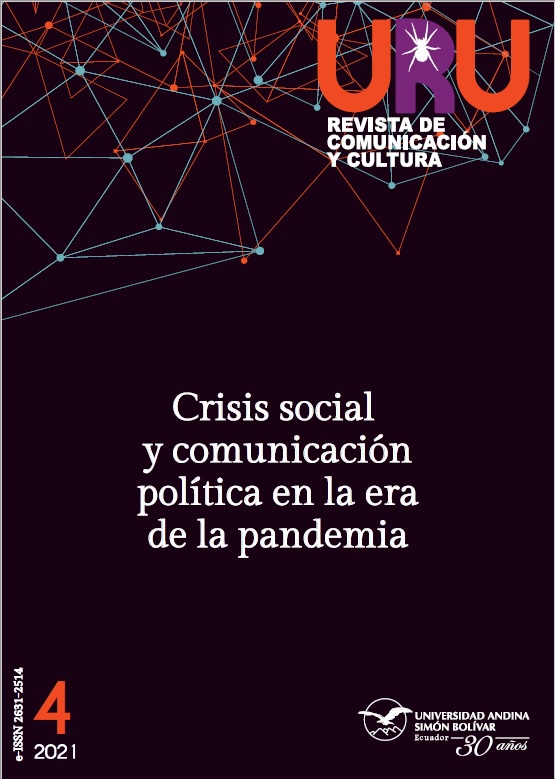Communication and Misinformation in Times of COVID-19 in Ecuador
DOI:
https://doi.org/10.32719/26312514.2021.4.5Keywords:
Disinformation, infodemic, data visualization, communication, fake newsAbstract
The COVID-19 pandemic exposed not only the structural problems of health systems on a global scale, but also problems in effective communication of the crisis and how to avoid or at least contain it. These problems were also affected by the proliferation of misinformation on topics as varied as treatments, symptoms, origins or ways to prevent its spread. Although, the verification platforms fulfill an important task to counteract the so-called fake news, the amount of information and misinformation that circulated in the first months of the pandemic was so great that an effort is needed that covers more fronts to be able to communicate efficiently the phenomenon and its different edges. The verifications made by Ecuador Chequea during the first semester of 2020 were classified under qualitative criteria such as the emotions they provoke or the subject to which they refer and through the use of Information Design and Data Visualization tools, graphic pieces were developed that show the relationship between the production of information and the development of the pandemic in Ecuador. Once this was done, it was necessary to communicate the findings and this work presents the development and quantitative results of the communication campaign on social networks designed to help educate the general public to distinguish misinformation.
Downloads
References
Bayas, K. 2020. “Visualización del contexto de las fake news para entender la infodemia”. #PerDebate 4: 90-109.
Código Vidrio. 2020. “Así propaga el correísmo el virus del miedo en redes”. Código Vidrio. 30 de marzo. https://bit.ly/3fp9tPo.
Costa, J. 1998. La esquemática: Visualizar la información. Madrid: Paidós.
Cusot, G. e I. Palacios. 2019. “Las fake news y las estrategias de verificación del discurso público: Caso Ecuador Chequea”. #PerDebate 3: 88-107.
EC INEC. 2019. “Tecnologías de la Información y Comunicación: Encuesta Multipropósito–TIC”. Instituto Nacional de Estadística y Censos. https://bit.ly/3wDV1sG.
Ecuador Chequea. 2021. “Quiénes somos”. Ecuador Chequea. Accedido 28 de mayo. http://www.ecuadorchequea.com/quienes-somos.
Frascara, J. 1999. El poder de la imagen. Buenos Aires: Infinito.
GB Government Communication Service. 2019. “RESIST: Counter-Disinformation Toolkit”. Government Communication Service. https://bit.ly/3vxNaga.
Montesi, M. 2020. “Las fake news sobre el COVID-19: ¿qué aprendemos de ellas?” (inédito). https://bit.ly/3wBqdIU.
OMS. 2020. "Gestión de la infodemia sobre la COVID-19: Promover comportamientos saludables y mitigar los daños derivados de la información incorrecta y falsa". Organización Mundial de la Salud. 23 de septiembre. https://bit.ly/2ULeOJg.
Posetti, J., y K. Bontcheva. 2020a. “Desinfodemia: Descifrando la desinformación sobre el COVID-19”. Unesco. https://bit.ly/3yHgt1D.
—, y K. Bontcheva. 2020b. “Desinfodemia: Disección de las respuestas a la desinformación sobre el COVID-19”. Unesco. https://bit.ly/3bZq8H2.
Shaoqiang, W. 2017. Infografía. Barcelona: Promopress.
Ware, C. 2013. Information Visualization. Waltham, MA, US: Morgan Kaufmann.
Zarocostas J. 2020. “How to Fight an Infodemic”. Lancet 395 (10225): 676. https://doi.org/10.1016/S0140-6736(20)30461-X
Downloads
Published
How to Cite
Issue
Section
License
ASSIGNMENT OF RIGHTS, DECLARATION OF CONFLICT OF INTEREST AND DISSEMINATION
The authors who publish in this journal accept the following conditions:
- Authors retain copyright and grant the journal the right of first publication, with the work registered under the Creative Commons Attribution-NonCommercial-ShareAlike 4.0 License, which allows sharing, adapting and attributing the work (see: Open Access Policies).
- Authors can make other independent and additional contractual agreements for the distribution of the article published in this journal (e.g., include it in an institutional repository or publish it in a book) as long as they expressly indicate that the article was published for the first time in Uru: Revista de Comunicación y Cultura. In the case of reproduction, a note similar to the following must be included: This text was originally published in the journal Uru: Revista de Comunicación y Cultura N ° -, year of publication.
- Authors are encouraged to publish their work on the Internet (e.g. on institutional or personal pages) in the final version published by Uru: Revista de Comunicaicón y Cultura as it may lead to a wider and faster dissemination of the published work.








